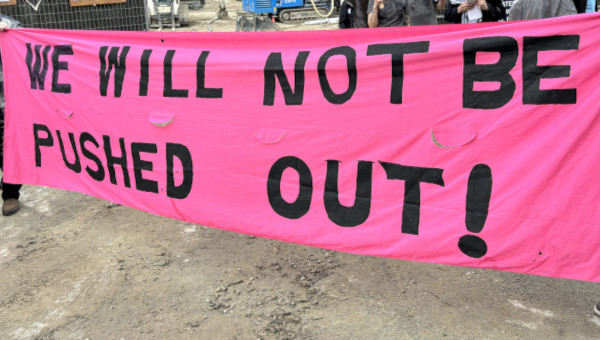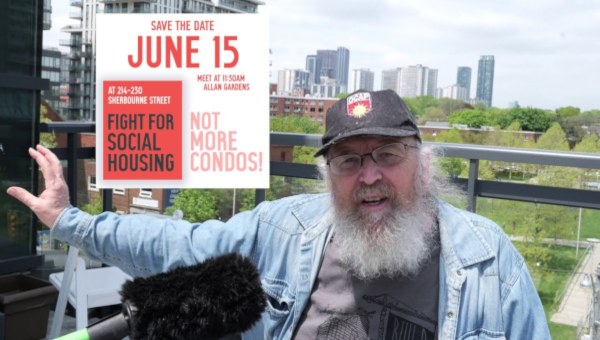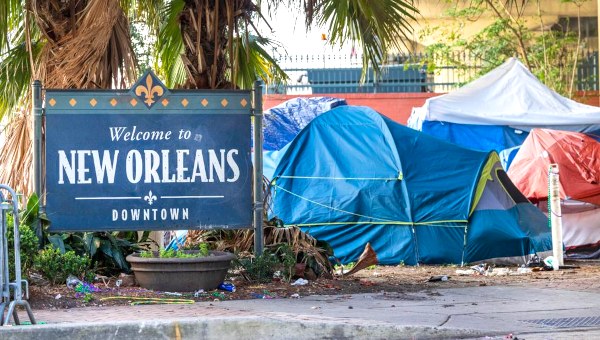The Mayor’s Office in Toronto is today occupied by a much slicker operation than it was during the years of dysfunctional, bigoted buffoonery that unfolded under Rob Ford. Mayor John Tory has resumed the drive toward a fully fledged neoliberal city but has the basic political skills to frame his twin agendas of austerity and upscale redevelopment in the language of inclusiveness. He has been sufficiently proficient at this to rapidly create what Michael Laxer has termed an “austerity consensus” supported by the overwhelming majority of the Council, including its left wing.
The agenda of the developers with regard to the central part of Toronto is to complete the creation of an interwoven hive of business, commerce, upscale recreation and high end housing. Standing in the way of this are enduring pockets of housed poverty and a considerable and growing homeless population. Those without housing, very understandably, have tended to gravitate toward the centre of the city and, over many years, shelters and other services have developed in this area. This situation is resented by those working for upscale redevelopment and not only because visible destitution impacts property values and ‘quality of life’ for those with the money to pay for it. It is also the case that the shelters, drop-ins and service agencies that homeless people turn to are located in areas that the forces of gentrification are laying claim to.
The General Manager of Shelter, Support and Housing Administration (SSHA) has submitted an “Infrastructure and Service Improvement Plan for the Emergency Shelter System” to the Community Development and Recreation Committee of City Council. It is a startling plan to remove homeless shelters from the centre of the city on a mind boggling scale. I’ll return the focus shortly to this aspect of the report but, before that, I want to note that it also represents a response by the bureaucracy to the dramatic worsening of the homeless situation, the extreme overcrowding of the shelter system and to community based political action has been taken up on these issues.
Tragic Deaths Force the City to Act
On page 7 of the report we learn that, between January 2011 and January 2015, shelter use in Toronto increased by 11 per cent and there is no reason to think this trend will be reversed in the foreseeable future. In this worsening situation, there has been a longstanding struggle to ensure that the number of available shelter beds is adequate to meet the needs. This has largely focused on demanding that the City’s policy of ensuring a maximum shelter occupancy rate of 90 per cent was actually enforced instead of being wilfully disregarded. At the beginning of this year, four tragic homeless deaths, and community action that was taken in response to them, forced the politicians and the administration to adopt some concrete initiatives that moved toward meeting the policy [see Bullet No. 1077]. Mayor Tory went to some lengths to ensure these measures were put in place. As socially regressive as his regime may be, it is sophisticated enough to understand that street deaths, especially from the cold, are simply too glaring an indictment of how the city is run and that a few million dollars to lower the risk of such tragedies is money well spent.
So, we have a staff report that responds, to some degree, to the need to reduce overcrowding in the shelters but is primarily concerned with clearing the way for the redevelopment agenda. In this, it focuses on three objectives. Firstly, it proposes to remove a portion of long term shelter users and place them in housing. Secondly, it looks at opening additional space and increasing capacity in the system somewhat. Finally, it uses the opportunity to advance a plan to relocate shelter facilities in outlying areas of the city.
The General Manager gives over part of his report to a glowing appraisal of the prospects for “Housing First approaches for long term shelter users.” On page 12, we learn that those who have been in shelters for more than one year “represented 10 per cent of all shelter users in 2014, but used 32 per cent of all shelter beds available.” Given this situation, the administration proposes to try and house some of this portion of the shelter population. Of course, no one is going to suggest that people should have to live their lives as residents of homeless shelters. However, the report is really offering very little when all is said and done. On page 14, a goal of reducing the long term users by 20 per cent by housing them is set out, that would not make a decisive difference if it could be achieved, given the fact that the homeless population is growing so significantly. Moreover, it is necessary to temper enthusiasm around this initiative with a more realistic understanding of how the City’s Street to Homes initiative has actually played out in practice.
On the second point, the report does concern itself with the question of reducing shelter occupancy so as to comply with the 90 per cent policy. However, this objective is not something that will be pursued with any sense of urgency but will, supposedly, be worked out along the way in the process of relocating shelters in outlying areas of the city. Tellingly, the section (page 14) that deals with meeting the “Council-approved 90 per cent occupancy threshold” poses this, not as a policy that must be implemented without delay but simply as a ‘target’. Under community pressure, some measures have been taken and others are proposed, including restoring ‘surge capacity’ by ending the daily reliance on ‘flex beds’ (page 16), but the tone of this report makes clear that bureaucratic foot dragging on occupancy levels remains and will have to be confronted on an ongoing basis.
Massive Relocation
The huge change in the situation that we must now deal with, however, is that all efforts to address the condition of the shelters and their appalling levels of overcrowding will now take place in the context of a drive to relocate them on a massive scale. At the heart of this, will be the infamous “George Street Redevelopment” project. Driven by encroaching gentrification, including and particularly the
nearby 46 storey Pace Condo Tower that we have previously targeted and mobilized against, plans have been formulated to permanently remove all but 100 of the 334 emergency men’s shelter beds that are presently provided at Seaton House and the Schoolhouse shelter, which is located next door to it. 170 transitional beds would also be lost. Demolition will begin in 2017 if the plan is implemented (page 17) and, for a three year period, the entire homeless population on the street, all 674 of them, would be relocated.
As serious as this all is, it’s clear that the process of displacement is by no means limited to George Street. On page 17, we are told that “pressure created by a rising real estate market and the need to upgrade existing shelter facilities to better meet clients needs will result in several changes in the shelter system over the next five years.” I’d not be quite as ready as the SSHA bureaucracy to accept that the appetites of the real estate market can be reconciled with ‘clients needs’. What’s clear, though, is that the developer’s wishes are law as far as the City is concerned and, if condos or commercial projects need to be built where homeless people take shelter, the homeless will just have to move on.
The removal process is already upon us. The 124 bed Hope Shelter at McCaul and College Streets is set to close on April 14 and the report confirms that “At least one other shelter will need relocation this year as a result of their leased property being sold. Two other shelters may require relocation due to unsuitable conditions and poor state of repair of facilities” (page 17). Beyond even this, “…over the next few years, a total of six shelters will have to relocate” (not counting the impact of the removals on George Street) (page 17) and it’s clear that any additional space that is opened to meet the need to reduce occupancy levels will not be located in the central area if the developers and the City are able to determine the outcome.
The plan being advanced by SSHA is a total disaster for homeless people in Toronto. It is a reckless adaption to the needs of property owners and developers that simply cannot be allowed to proceed. On page 18, the report seems concerned that “..fifty three per cent of all shelter beds are concentrated in three downtown wards” while twenty one wards have none at all. So, “underserved locations outside of the downtown core should be prioritized for new shelters.” Of course, the outlying portions of the city are also ‘underserved’ when it comes to banking towers and corporate headquarters. There’s a reason why Bay Street isn’t located in Rexdale or that Toronto City Hall isn’t perched on the edge of the Rouge Valley. Equally obviously, people who face destitution tend to congregate in core urban areas to try and survive. Scan this report as thoroughly as you will but you will not see any proposals for how you can possibly meet the survival needs of people you dump outside the city core. Where will you locate drop-ins and support agencies? How will you overcome the fact that people will be left to fend for themselves in parts of the city where distances between service providing facilities are measured in miles instead of blocks?
Social Cleansing
We are dealing with an exercise in social cleansing that would be nothing less than tragic. Four homeless men died in this city during January and the Toronto Homeless Memorial continues to chart an appalling toll of homeless people perishing. Removing people to fend for themselves in the outlying parts of the city would increase the risk of such deaths considerably.
What is even more alarming about this forced relocation plan is that it is the danger that the plug will be pulled on existing facilities before firm arrangements in ‘underserved’ suburbs are even in place. You can just imagine the NIMBY backlash that awaits efforts to place hundreds of homeless people outside of the core. Good luck telling Rob Ford and his neighbours they are going to have a homeless shelter around the corner from them. The grim situation around the Hope Shelter is a sign of things to come. No replacement has been found with three weeks to go to the deadline. The church based Out of the Cold program will wind up for the year just before the Hope closes its door. That some of the men in there have been found housing is not the main question. What about all the other homeless who need the 124 beds that will be taken out of the system if this closing is allowed to happen?
Beginning with the Hope Shelter, we have to resist these closings and the relocation process. We must build the broadest community and union alliance to challenge it and be ready to occupy facilities to prevent them being locked up or take the necessary action to open new space. We must fight to prevent this driving out of homeless people. It is an exercise in reckless social abandonment that will not stop at targeting those forced onto the streets. Those in public housing and other low income tenants will also continue to be slated for removal
at an increased pace. This is really about challenging the notion that Toronto should be a City where the investment needs of developers, bankers and business owners get to prevail unchecked. In the weeks ahead, we’ll be developing plans to fight back against this outrage and will be asking for maximum support as we put those plans into effect. Please be ready to show your solidarity with homeless people facing this attack. •





